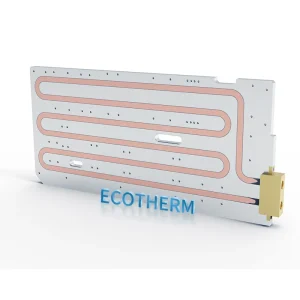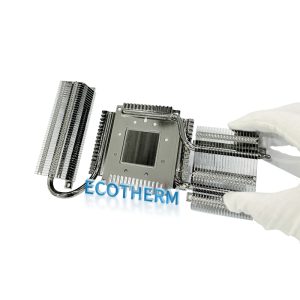A Guide to Cold Plate Flow Channel Design and Material Selection
shows the typical thermophysical properties of common coolants. As evident from this data, the selection priority—when other conditions are constant—is given to mediums that meet environmental requirements (e.g., altitude, ambient temperature) and offer a lower cost.
However, the cold plate stands out as the system’s crucial heat exchange component, featuring internal heat transfer structures known as flow channels. The significant variations in the design of these flow channels introduce great variability, profoundly influencing the overall system’s heat exchange efficiency.
Therefore, this guide will focus specifically on the design and optimization strategies for the cold plate’s flow channels, using pure water as the cooling medium example.
Essential Design Requirements for Cold Plate Structure
To ensure the cold plate is reliable, efficient, and cost-effective, its structural design must satisfy a series of multi-disciplinary requirements:
Thermal Performance Requirements: Must achieve the heat source’s target temperature rise and the required thermal resistance, based on set flow rate and inlet/outlet temperature differences.
Strength and Pressure Requirements: Specific projects may require detailed consideration of surface pressure and overall structural integrity due to the operating environment or installation position within the system.
Corrosion Resistance Requirements: The long-term flow of the liquid medium, especially at high temperatures, can accelerate material degradation, potentially leading to blockages and a decrease in cooling performance.
Leak Prevention Requirements: Design methods such as cover plate design, end face sealing, using gaskets, or specific welding techniques are necessary to ensure a leak-proof system.
Cost-Effectiveness Requirements: Optimization across manufacturing feasibility, material choice, process complexity, and managing fluid/thermal resistance to minimize pump pressure and labor costs.
Satisfying all these criteria necessitates a comprehensive design process integrating material science, structural engineering, and manufacturing methodologies.
Strategic Material Selection for Enhanced Heat Transfer
The material of the cold plate directly dictates the heat transfer efficacy between the channels and the coolant. Using materials with high thermal conductivity is paramount for minimizing the system’s overall thermal resistance.
Common materials, represented by aluminum and copper, have distinct properties.
lists the properties of these common materials. Aluminum alloys are the most widely used choice due to their high thermal conductivity, low density, excellent machinability, robust corrosion resistance, and favorable mechanical properties.
Mature anti-corrosion treatments for aluminum profiles ensure the cold plate’s long-term reliability. For electronics, 50-series and 60-series aluminum alloys (e.g., AL5051, 6061, 6063) are frequently selected, as they offer the necessary thermal and anti-corrosion characteristics, are suitable for anodic oxidation, and can be CNC machined to create complex flow channels.
Overview of Basic Cold Plate Flow Channel Patterns
With the fluid flow rate and basic pressure drop requirements established, the design and optimization of the internal flow path become the focus. The flow channel patterns significantly impact the heat exchange area and fluid dynamics. Common styles include:
Planar (Straight Channels):
(Planar Cold Plate physical view)
Serpentine (W-Type) Channels:
(W-type Cold Plate physical view)
Annular (Ring-Shaped) Channels:
(Annular Cold Plate physical view)
Cylindrical/Pillar Enhanced Channels:
(Cylindrical Cold Plate physical view) This is a typical case, where the internal structure can also be rectangular ribs to maximize the water flow contact area.
Archimedean Spiral Channels:
(Archimedean Spiral Channel physical view)
These basic structures can be combined or modified.
For instance, the spiral design can be implemented as a Single-Loop Channel or a Dual-Loop Channel
to achieve specific cooling effects. Through various combinations, engineers can reach unexpected efficiencies.
Flow Channel Optimization Principles and Methods
Flow channel optimization is essential for maximizing cooling efficiency while managing pressure drop. The key optimization principles include:
Increase Flow Circuits: If initial thermal simulations show insufficient performance (high thermal resistance), consider increasing the number of circuits (e.g., upgrading from a single loop to a dual loop or more) to enhance heat transfer.
Maximize Surface Area: If space permits, incorporate internal structures like cylindrical or square fins/ribs in staggered or in-line arrangements to increase the heat exchange area.
Optimize Flow Velocity: The internal channel cross-sectional area directly affects velocity. While reducing the area increases velocity for better heat transfer, it also significantly increases flow resistance (pressure drop). A balance is required.
Ensure Uniform Cooling: The flow path should cover the entire area over the heat source as evenly as possible. For constrained or small areas, the Archimedean spiral channel is an excellent option for balanced coverage.
Prevent Short Circuits and Overly Long Paths: Avoid placing the inlet and outlet too close to prevent coolant from bypassing the main heat source area. For complex, stacked heat sources, segmenting the cooling (e.g., per layer) prevents excessive temperature differences between the beginning and end of a long flow path.
Smooth Flow Transitions: Minimize sharp turns, as they increase head loss and internal flow resistance. When turns are unavoidable, design them with a smooth radius to reduce pressure drop while maintaining an effective flow path.
The optimization process should follow a systematic approach:
Hypothesis Analysis: Based on existing designs, theoretically calculate the expected results of optimization strategies (e.g., increasing surface area, decreasing cross-section, adding circuits).
Numerical Simulation (CFD): Develop multiple channel design models based on the hypothesis and conduct computational fluid dynamics (CFD) simulations under specified operating conditions for comparative analysis.
Experimental Validation: Build physical prototypes and conduct experiments to verify the accuracy of both the hypothesis analysis and the simulation results.



